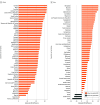Global Disparities of Cancer and Its Projected Burden in 2050
- PMID: 39499513
- PMCID: PMC11539015
- DOI: 10.1001/jamanetworkopen.2024.43198
Global Disparities of Cancer and Its Projected Burden in 2050
Abstract
Importance: Cancer prevention and care efforts have been challenged by the COVID-19 pandemic and armed conflicts, resulting in a decline in the global Human Development Index (HDI), particularly in low- and middle-income countries. These challenges and subsequent shifts in health care priorities underscore the need to continuously monitor cancer outcome disparities and statistics globally to ensure delivery of equitable and optimal cancer prevention and care in uncertain times.
Objective: To measure the global burden of 36 cancers in 2022 by sex, age, and geographic location and to project future trends by 2050.
Design, setting, and participants: This cross-sectional study used population-based data from 2022 in 185 countries and territories were obtained from the Global Cancer Observatory database. Data extraction and analysis were carried out in April 2024.
Main outcomes and measures: Counts, rates, prevalence, mortality to incidence ratios (MIRs), and demography-based projections were used to characterize current and future cancer burden.
Results: This population-based study included 36 cancer types from 185 countries and territories. By 2050, 35.3 million cancer cases worldwide are expected, a 76.6% increase from the 2022 estimate of 20 million. Similarly, 18.5 million cancer deaths are projected by 2050, an 89.7% increase from the 2022 estimate of 9.7 million. Cancer cases and deaths are projected to nearly triple in low-HDI countries by 2050, compared to a moderate increase in very high-HDI countries (142.1% vs 41.7% for cancer cases and 146.1% vs 56.8% for cancer deaths). Males had a higher incidence and greater number of deaths in 2022 than females, with this disparity projected to widen by up to 16.0% in 2050. In 2022, the MIR for all cancers was 46.6%, with higher MIRs observed for pancreatic cancer (89.4%), among males (51.7%), among those aged 75 years or older (64.3%), in low-HDI countries (69.9%), and in the African region (67.2%).
Conclusions and relevance: In this cross-sectional study based on data from 2022, cancer disparities were evident across HDI, geographic regions, age, and sex, with further widening projected by 2050. These findings suggest that strengthening access to and quality of health care, including universal health insurance coverage, is key to providing evidence-based cancer prevention, diagnostics, and care.
Conflict of interest statement
Figures


References
-
- Human Development Report 2021-22: Uncertain Times, Unsettled Lives: Shaping Our Future in a Transforming World. United Nations Development Programme . September 8, 2022. Accessed March 10, 2024. https://hdr.undp.org/content/human-development-report-2021-22
MeSH terms
LinkOut - more resources
Full Text Sources
Medical
Miscellaneous

